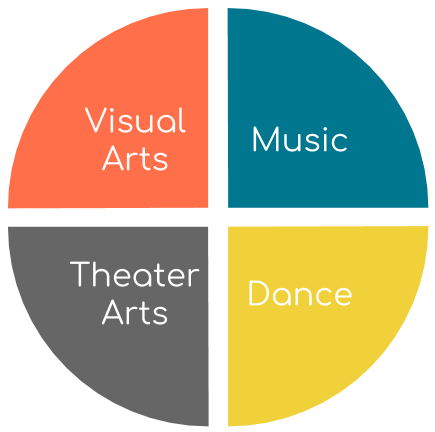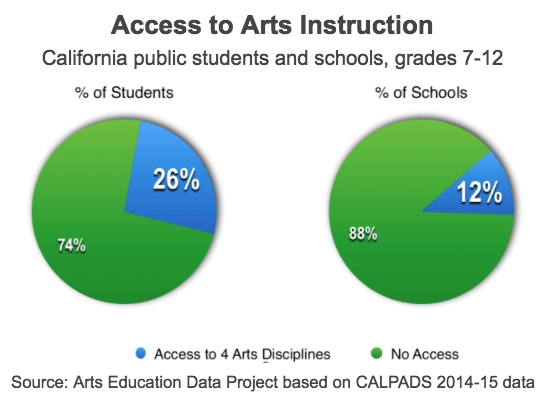Is Your School Flunking the Arts?

Is Your School Flunking the Arts?
A new interactive dashboard allows you to take a closer look at the availability of arts education in California's middle and high schools. And the results? Well, let’s say there is still a lot of work to be done.
Most California schools do not meet the state's minimum arts requirements. Chances are your school is on the list. (But perhaps not forever: we have some ideas for you. Read on…)
What is Required?

The occasional sketch or music experience does not make the grade. If kids at your school get just a smattering of arts education, take a gulp and look at what is really required.
It is not just drawing or music. California law specifies that the arts should include instruction (grades 1-6) or courses (grades 7-12) in four disciplines: dance, drama and theatre, music, and visual arts. That’s right. All of these.
Most California students get some arts instruction. But few have access to all four required arts disciplines. It was not always this way.
California collects data about the courses that students take, including courses in the arts, through the CALPADS system. What do the numbers look like? Take a look:
- 86% of schools report offering at least one course in the arts.
- 39% of students are enrolled in some arts.
- Just 12% of California's middle and high schools offer all four arts courses.
What About Your School?
How well is your school doing? You don't have to wonder: Check here.
Advocating for the Arts
If your school is one of the ¾ that doesn't have a full course offering in the arts, you might be wondering what to do about it. Hint: It does not happen overnight. It takes persistence, planning and a common understanding in your community that the arts are essential for every child in every school.
The California Alliance for Arts Education (artsed411.org) is a great resource for information about advocacy efforts for arts education in California. [Editor's note: Carol once served on the board.] In 2018, this organization committed its support to the Arts for Every Student Incentive Grant Program (SB 933). The measure would create a competitive state grant program to encourage and maintain the delivery of high-quality visual and performing arts education programs and to provide a jump start for school districts lacking the capacity to provide access to arts for every pupil. You can find background information in this fact sheet .
Community Building
Because local school district budgets are crucial for arts education, community commitment is vital. It starts with parents, teachers, administrators and school boards understanding the importance of the arts to learning. You can start at your own school!
- SchoolSmarts is an award-winning family engagement program of the California State PTA that incorporates arts activities. One of its goals is to help families understand the importance of arts education. Find out how your school can participate.
- The SMARTS for the ARTS newsletter can help you stay informed.
- A parent meeting or family arts night is a great opportunity to discuss how your school and school district provide access to the arts—or don't. Share research on the the impact of arts on education. Americans for the Arts, a nonprofit organization, suggests some ways to get the point across visually.
- The PTA Reflections program gives students a chance to create and be recognized for original works of art and serves to increase community awareness of the importance of the arts to learning.
Take it to the Board
Your school board is where decisions are made about whether and how to spend resources on the arts. Are they committed? Ask them. Here are examples of action steps:
- Your school board could adopt the Declaration of the Rights of All Students to Equity in Arts Learning. Create CA recognizes districts and organizations on a statewide map of Arts Equity Districts and Champions.
- Your school district could get involved with the Arts Now Planning Initiative. This helps California districts and counties complete a planning process to assess, envision, and implement quality visual and performing arts programs for their students.
- Your school district could use Local Control funding and Title 1 Federal money to support student learning through the arts.
The Elephant in the Room
Money. You can find support for the arts through community organizations, partnerships, and other strategies. But until there is sufficient funding for schools in California, the arts, along with many other programs, will continue to struggle.
Some school communities have voted to support the arts and have made dramatic improvements in delivering arts to all students. San Francisco is a good example. But statewide, funding still is skimpy and that has a profound impact on what your school district can provide.
Tags on this post
LCFF Local control Arts DataAll Tags
A-G requirements Absences Accountability Accreditation Achievement gap Administrators After school Algebra API Arts Assessment At-risk students Attendance Beacon links Bilingual education Bonds Brain Brown Act Budgets Bullying Burbank Business Career Carol Dweck Categorical funds Catholic schools Certification CHAMP Change Character Education Chart Charter schools Civics Class size CMOs Collective bargaining College Common core Community schools Contest Continuous Improvement Cost of education Counselors Creativity Crossword CSBA CTA Dashboard Data Dialogue District boundaries Districts Diversity Drawing DREAM Act Dyslexia EACH Early childhood Economic growth EdPrezi EdSource EdTech Education foundations Effort Election English learners Equity ESSA Ethnic studies Ethnic studies Evaluation rubric Expanded Learning Facilities Fake News Federal Federal policy Funding Gifted Graduation rates Grit Health Help Wanted History Home schools Homeless students Homework Hours of opportunity Humanities Independence Day Indignation Infrastructure Initiatives International Jargon Khan Academy Kindergarten LCAP LCFF Leaderboard Leadership Learning Litigation Lobbyists Local control Local funding Local governance Lottery Magnet schools Map Math Media Mental Health Mindfulness Mindset Myth Myths NAEP National comparisons NCLB Nutrition Pandemic Parcel taxes Parent Engagement Parent Leader Guide Parents peanut butter Pedagogy Pensions personalized Philanthropy PISA Planning Policy Politics population Poverty Preschool Prezi Private schools Prize Project-based learning Prop 13 Prop 98 Property taxes PTA Purpose of education puzzle Quality Race Rating Schools Reading Recruiting teachers Reform Religious education Religious schools Research Retaining teachers Rigor School board School choice School Climate School Closures Science Serrano vs Priest Sex Ed Site Map Sleep Social-emotional learning Song Special ed Spending SPSA Standards Strike STRS Student motivation Student voice Success Suicide Summer Superintendent Suspensions Talent Teacher pay Teacher shortage Teachers Technology Technology in education Template Test scores Tests Time in school Time on task Trump Undocumented Unions Universal education Vaccination Values Vaping Video Volunteering Volunteers Vote Vouchers Winners Year in ReviewSharing is caring!
Password Reset
Search all lesson and blog content here.
Login with Email
We will send your Login Link to your email
address. Click on the link and you will be
logged into Ed100. No more passwords to
remember!
















Questions & Comments
To comment or reply, please sign in .
Ken R May 8, 2018 at 4:02 pm
Jeff Camp May 29, 2018 at 9:53 pm